Sequoia capital AI Summit: One of the biggest opportunities for AI is to replace services with software.
Sequoia capital is hosting the AI Ascent 2024 conference these days, where three partners of Sequoia, Sonya Huang, Pat Grady, and Konstantine Buhler, have gathered 100 leading AI founders and researchers to discuss the opportunities, current status, and impact of AI. The insights shared by these three partners of Sequoia were very impressive, and some of the viewpoints resonated with what I have written before, such as the application of AI in the legal industry, customer service industry, and programming field. Here are a few interesting viewpoints that caught my attention:
One of the biggest opportunities for AI is to replace services with software, because AI possesses human-like interaction capabilities.
The creative and reasoning abilities of AI mean that software has, for the first time, acquired human-like interaction capabilities, which is crucial as it signifies a profound transformation in business models.
AI has already found Product-Market Fit (PMF) in the customer service field.
AI has a clear path to the future, as applications will continue to improve.
Computational resources will shift from pre-training to inference.
Essentially, we are building very complex abstraction layers on top of the basic elements of AI.
Hello everyone, I am Pack Grady, a partner at Sequoia Capital. Today, along with me, my partners Sonya Huang and Constantine are co-hosting the AI Summit. Over the past year, the field of AI has undergone significant changes. AI's biggest opportunity is to replace services with software because AI possesses human-like interaction capabilities. So, what opportunities does AI bring to us? A year ago, AI seemed like a magical black box that could create many wonderful things. Over the past 12 months, we have experienced a compressed version of the AI hype cycle: first, expectations inflated to a peak, then plummeted, and now we are gradually climbing, entering a stable highland. We realize that large language models and AI have brought us three new capabilities, which can be woven into various magical applications. First is creativity, which is also where Generative AI gets its name. AI can generate various content such as images, text, videos, audio, which was not possible with previous software. The second is reasoning ability, which can be single-step or multi-step reasoning similar to Agent, something that previous software couldn't achieve. With creativity and reasoning abilities, it is as if we have acquired the left and right hemispheres of the brain, which means that software has, for the first time, acquired human-like interaction capabilities, and this is crucial because it signifies a profound transformation in business models. We often try to understand new things through analogies. Although not perfect, it is still very inspiring. Here, the most appropriate analogy is the transformation of cloud computing over the past 20 years. Cloud computing was a major tectonic shift in the technology field, giving birth to new business models, new applications, and new human-computer interaction styles.
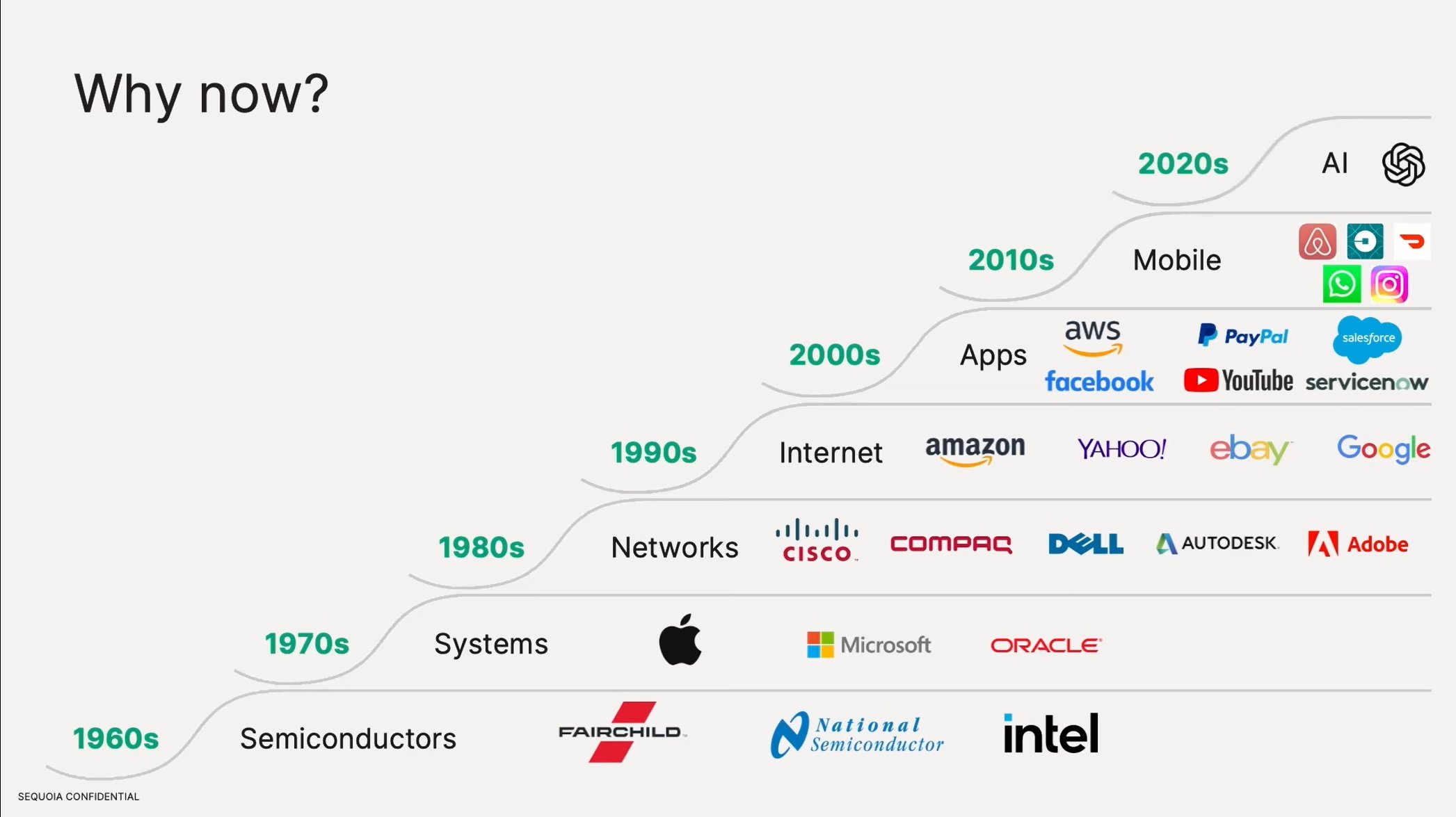
Looking back to around 2010, the global software market was about $350 billion, with cloud software accounting for a small portion, about $60 billion. By last year, the overall market size had grown to $650 billion, and cloud software revenue had reached $400 billion, with a staggering annual compound growth rate of 40% over 15 years. If we continue to use the analogy, cloud computing replaced software, and one of the biggest opportunities for AI is to replace services with software, because AI possesses human-like interaction capabilities. If we target this field, the starting point is not a few hundred billion, but possibly tens of trillions of dollars. You can imagine how large this market's growth space is. Our assumption is that humans are standing at the greatest value creation opportunity in history. Of course, this is only an assumption, and every point we discuss today is just an assumption. Why now? As a member of Sequoia, we have had the privilege to witness and study various technological waves, understanding how they intertwine and lead us to today. Let's quickly review the history:
In the 1960s, Sequoia's founder, Don Valentine, was responsible for marketing at Fairchild Semiconductor, which produced silicon transistors that made Silicon Valley famous;
In the 1970s, computer systems were built on the basis of chips; In the 1980s, personal computers were connected through networks, and the software package industry emerged;
In the 1990s, the Internet emerged, changing our communication and consumption methods;
In the 2000s, the Internet matured to support complex applications, and the era of cloud computing arrived;
In the 2010s, smartphones became popular, changing our work style; Every wave has pushed forward on the basis of the previous one. The concept of AI can be traced back to the 1940s, but turning AI from an idea into reality, solving practical problems, and creating sustainable businesses, required the technology and environment that have only been available in recent years: sufficient and inexpensive computational resources, fast and reliable networks, 7.8 billion people worldwide having smartphones, and the pandemic driving everything online, providing massive data for AI. Now is the moment for AI to become the theme of the next 10-20 years, and we firmly believe in this. How will this opportunity manifest? Let's compare it again to cloud computing and mobile internet. On the left, these companies are the revenue-generating companies that emerged from these two transformations. Interestingly, on the right, it's not about what is there, but what is not there.
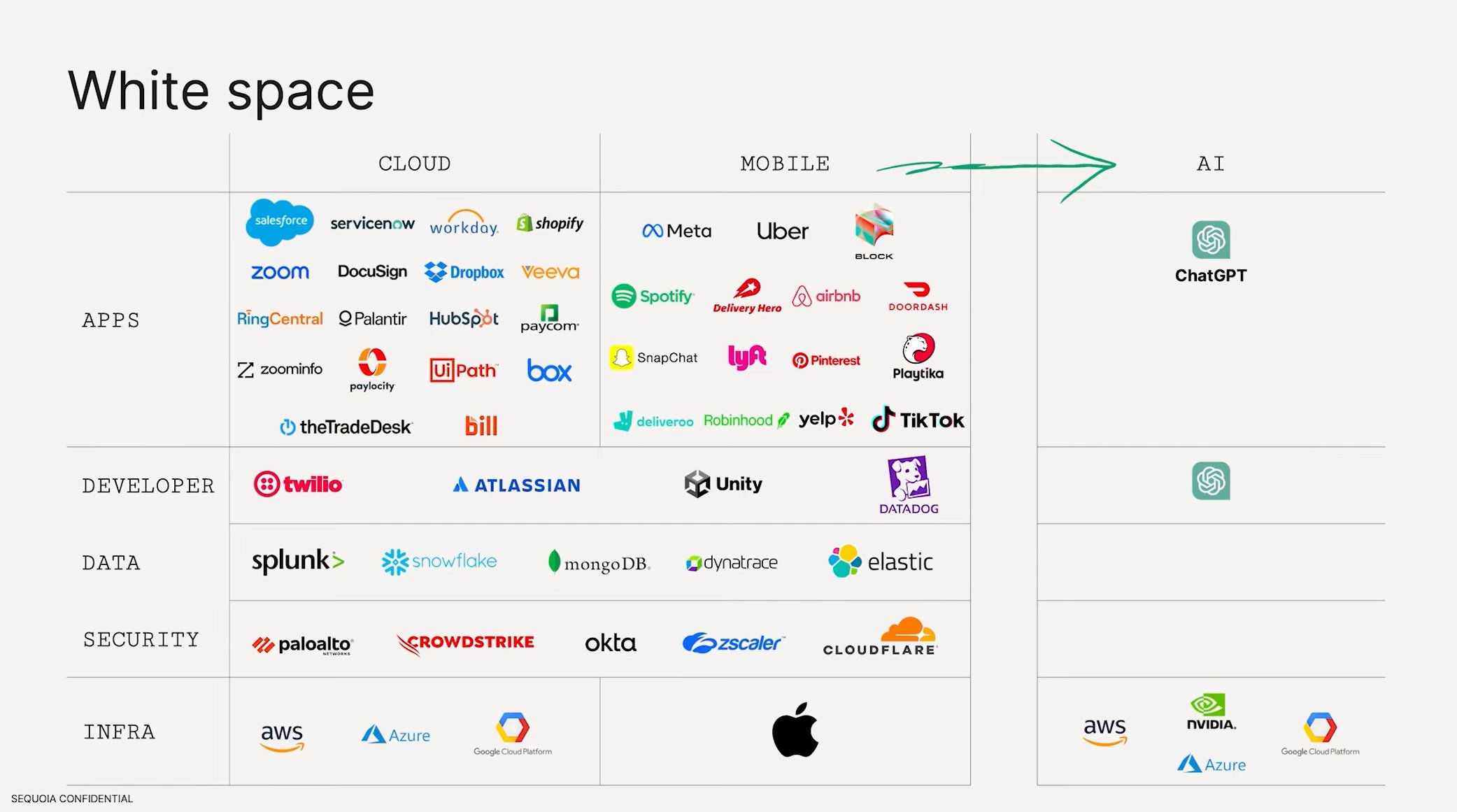
The future belongs to all of you, and the opportunities are limitless. We believe that if we look back in 10-15 years, there will be 40-50 companies on the right, and they are very likely to be in this room today. This is what excites us. Sonya Huang: AI has already found PMF in the customer service field. The past year has been extraordinary. From the release of ChatGPT to now, the ground has been constantly shifting and trembling for everyone present. Let's pause for a moment, take a bird's-eye view, and take stock of what has happened so far. Last year, we were discussing how AI would bring revolutionary productivity improvements in various fields. A year later, we are beginning to see some signs. You may have seen Sebastian's post on Twitter, Klarna now uses OpenAI to handle 2/3 of its customer service queries, equivalent to automating 700 full-time customer service representatives. There are tens of millions of call center customer service representatives worldwide, and AI has already found Product-Market Fit (PMF) in the customer service field
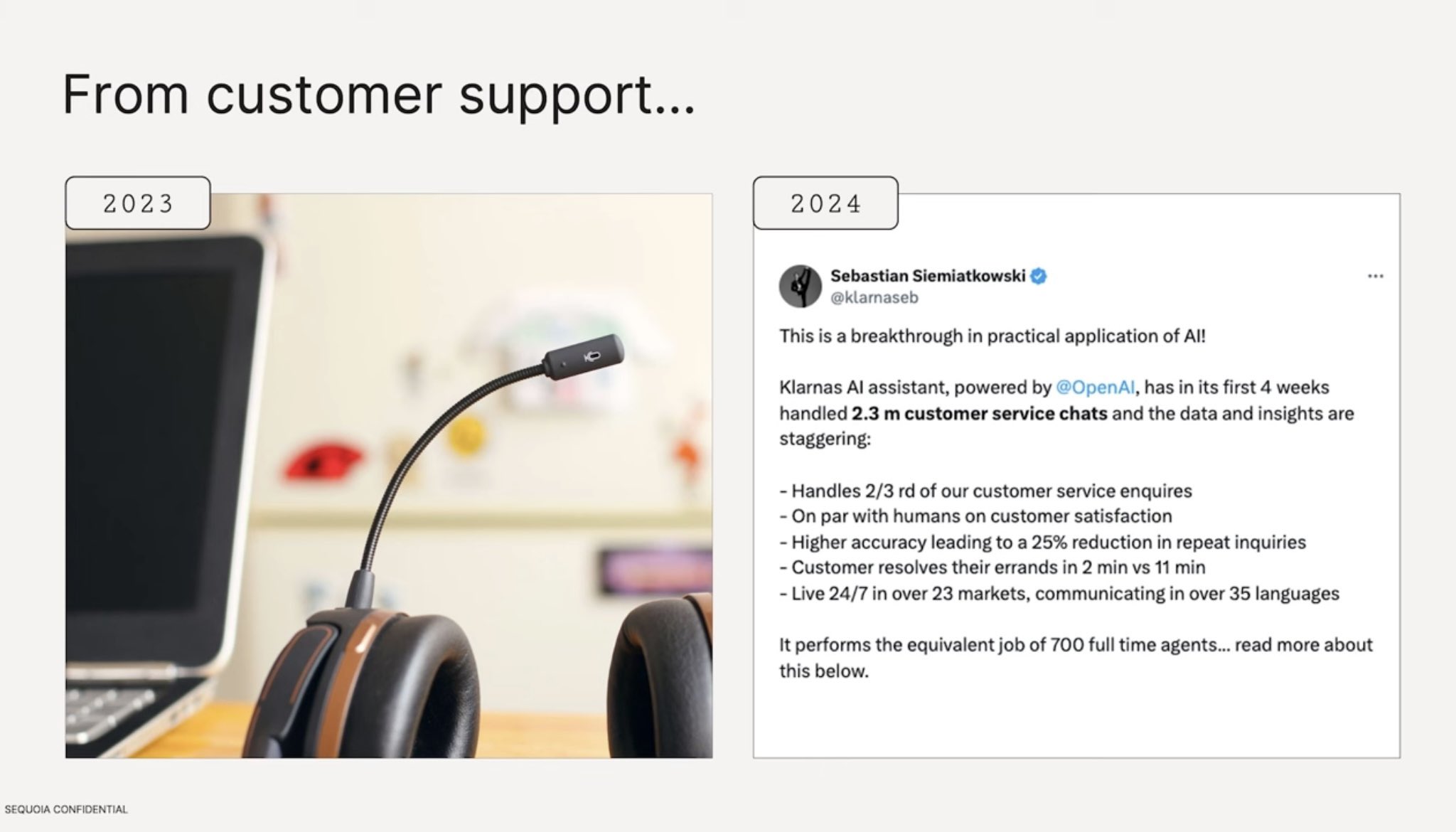
A year ago, the legal industry was considered one of the least willing to accept technology. But now companies like Harvey have emerged, automating the work of lawyers from daily routine tasks to more advanced analysis. You may have already seen some amazing demonstrations on Twitter. We have moved from "AI theoretically can help us write code" a year ago to fully automatic AI software engineers, which is exciting (see previous articles "AI is reshaping the legal industry" and "Legal AI Harvey's 12-month ARR exceeds $15 million, multiple legal AI companies receive funding again"). AI is not only for improving work efficiency but also for improving our quality of life. One day, during a meeting with Pat, I noticed that he seemed a bit suspicious, and didn't say a word throughout the meeting. Upon careful thought, I am certain that he sent an AI virtual image to the meeting while he went to the gym. Pat's AI virtual image mimicked his facial expressions perfectly. This is thanks to HeyGen, and I have to say that AI has made remarkable progress in just one year, both frightening and exciting. Two years ago, we thought that Generative AI might trigger the next technological revolution and didn't know what it would bring. Whether real companies could rise, whether substantial revenue could be generated, the scale of user and revenue growth has surprised everyone. We estimate that the total revenue generated by Generative AI models has reached $3 billion, and this is not including the revenue of the major cloud computing vendors.
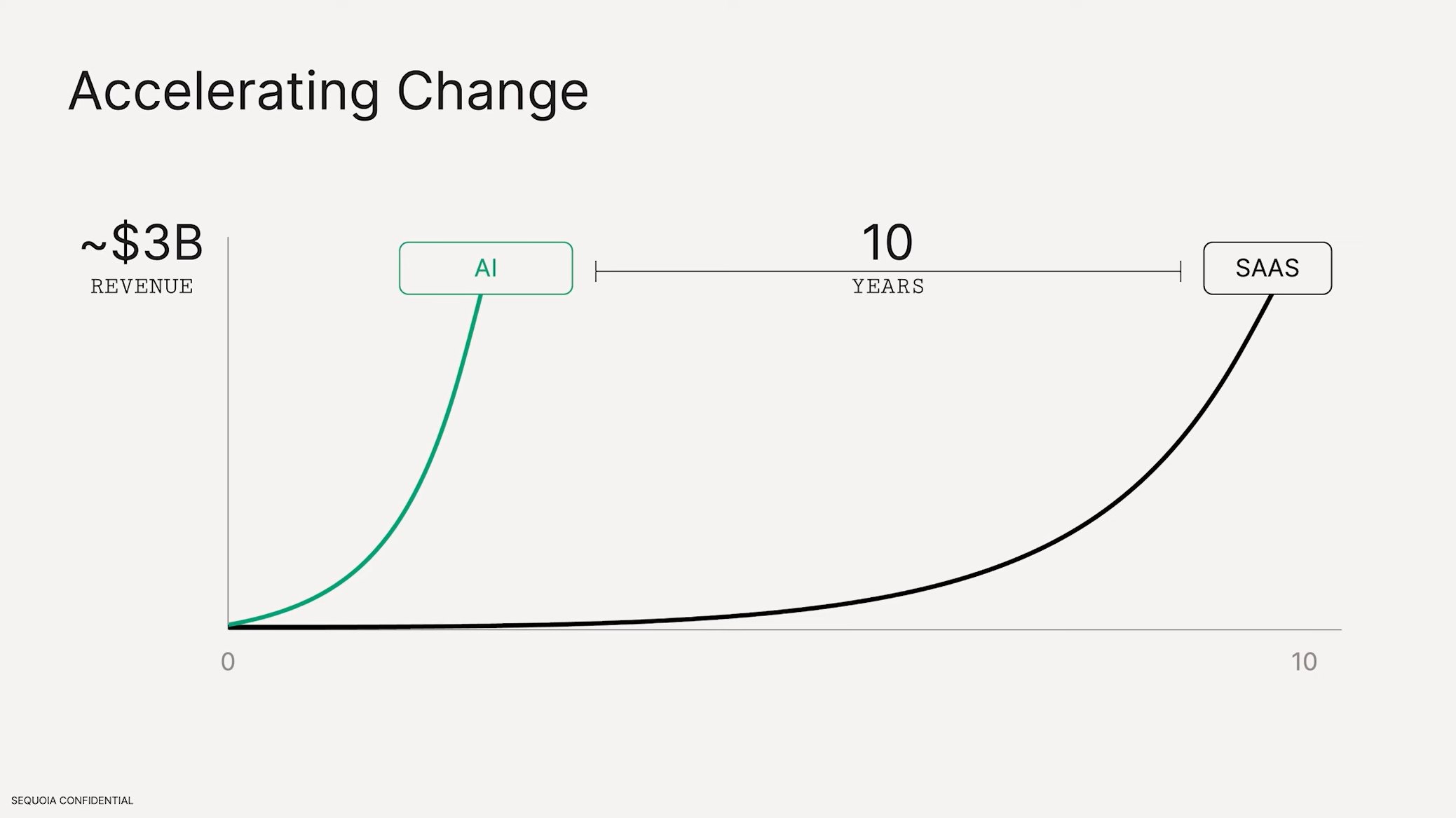
It is important to note that the imbalance in AI investment in the capital market over the past year has surprised me. If we compare Generative AI to a layered cake, the bottom layer is the basic model, the middle layer is developer tools and infrastructure, and the top layer is the application layer. A year ago, we expected to see a proliferation of applications at the application layer, as new technologies at the bottom layer would spur a large number of innovations. However, in reality, an increasing number of basic model companies have emerged and raised substantial funding, while the development of the application layer seems to have just begun. Our partner David published a thought-provoking article last year, "The $200 Billion Problem of AI." The scale of spending on Nvidia GPUs alone is astonishing, reaching $50 billion just last year, in addition to energy and data center costs. In contrast, we roughly estimate that the total direct and indirect revenue from AI is just over $30 billion. With an investment of $50 billion and a return of $30 billion, the investment and return are not in proportion, and this is a very real problem that needs to be addressed. Although AI has achieved remarkable results in terms of user numbers and revenue, the usage data tells us that it is still early days. Look at the ratio of daily active users to monthly active users, or the next month's retention rate; the performance
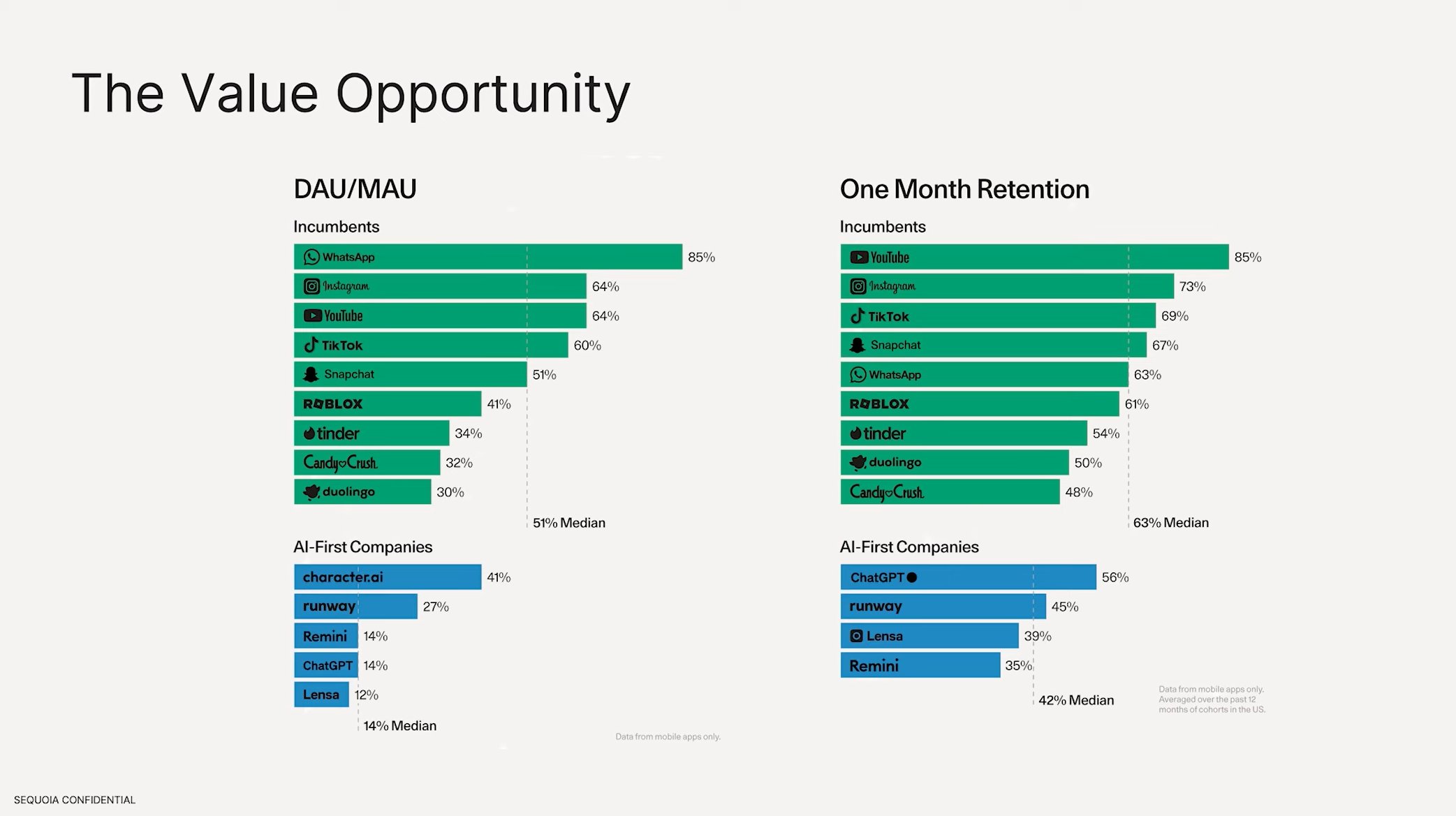
of Generative AI applications still lags behind that of mobile applications. This indicates that for most people, AI is still something they try out once a week or once a month. However, we have the opportunity to use AI to create applications that people want to use every day. When we interview users, a major reason for the low retention rate of AI applications is that the actual performance does not meet expectations. Some of the impressive demonstrations on Twitter may be disappointing in reality because the models are not intelligent enough to perform tasks effectively.
The good news is, with the staggering investment of $50 billion in GPU technology over the past year, we now have increasingly advanced basic models, such as the recently released Claude from Anthropic, GPT-4 from OpenAI, and Luminous from Aleph Alpha. With the improvement in the intelligence level of basic models, the product-market fit of AI applications is expected to accelerate. Unlike many other uncertain markets, AI has a clear path to the future, as applications will continue to improve.
We must remember that success takes time. We mentioned this last year, and we emphasize it again today. Looking back to the early days of the iPhone, the App Store was filled with fun but not very practical applications, such as beer drinking, magic tricks, beer glass tapping, and flashlights, some of which evolved into system-integrated applications, while others became irrelevant toys. It wasn't until 2010 that Instagram and DoorDash emerged, creatively leveraging the new capabilities of smartphones. We believe that AI is now telling a similar story. Although it is hard to imagine, the next legendary company might already be emerging.
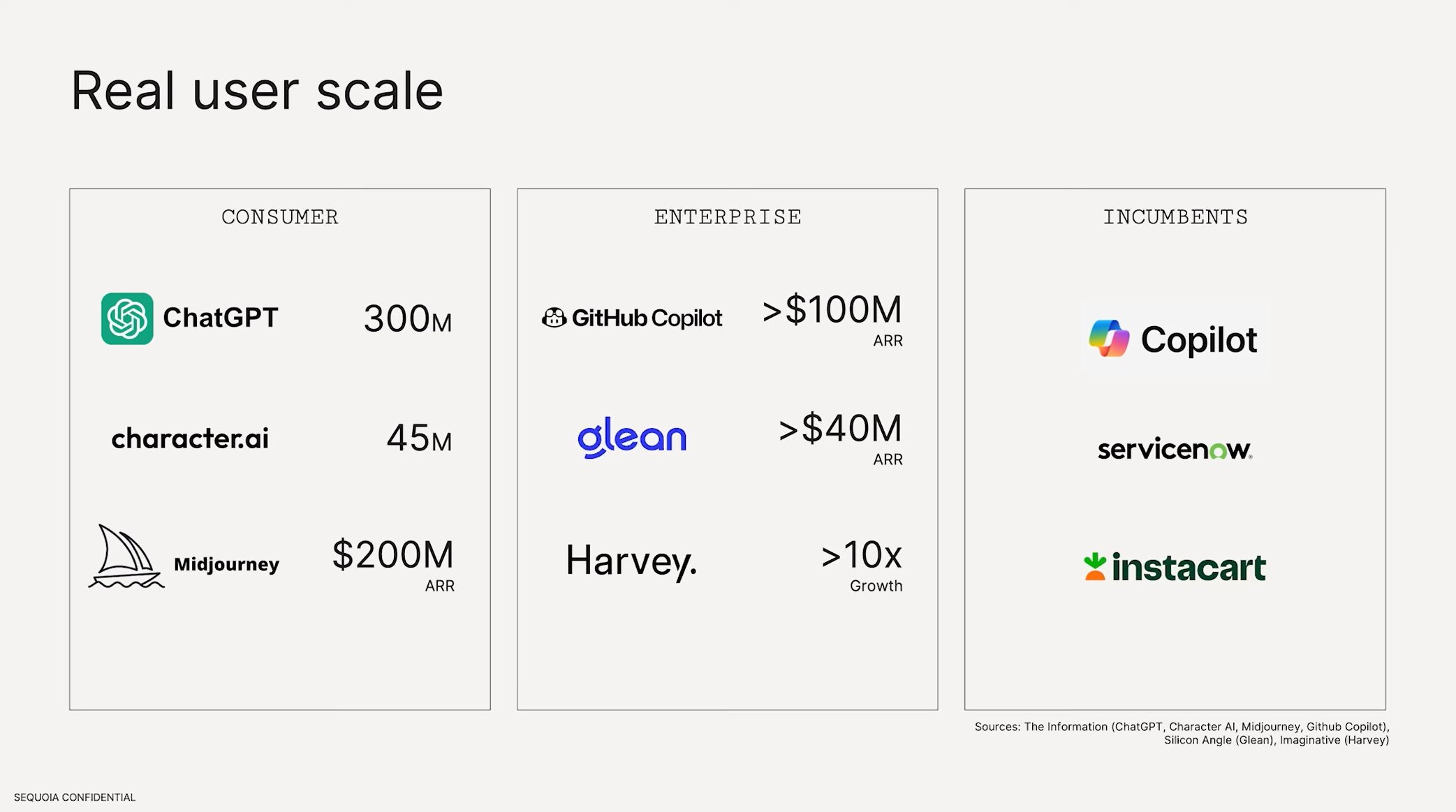
Now, let me introduce a few applications that have recently caught our attention. As mentioned earlier, Klarna is a prime example. We believe that customer service is one of the earliest areas in enterprise applications to find product-market fit, and this is not an isolated case. AI, as a companion, is creating unexpected yet intriguing application scenarios, and user engagement is high based on usage data. Later, we will hear from Glean and Dust about enterprise knowledge management, and we believe AI is opening new doors for enterprise knowledge management.
Looking ahead to the next year, I have a few predictions: First, in 2024, AI applications will evolve from assisting humans to fully automating systems in specific domains, allowing humans to exit certain workflows. We have already seen attempts in fields such as software engineering and customer service. Andrew Ng and Harrison Chase will discuss this further today. Second, a major issue with large language models is that they only match statistical patterns in text, rather than truly reasoning and planning. However, the latest research is attempting to give models planning capabilities, such as dynamically accessing external computational resources during the reasoning process and iteratively optimizing strategies similar to playing games. We expect this to be a major research direction for the major foundational model companies and anticipate that it will give AI stronger high-level cognitive abilities, such as planning and reasoning. Noan Brown from OpenAI will provide detailed insights on this later. Third, from interesting consumer applications to high-stakes enterprise applications, such as healthcare and defense, the demand for AI reliability is increasing. Various technologies, such as human feedback learning, prompt chaining, and vector databases, are helping large language models achieve reliability of over 95% in specific scenarios. We believe that today will be an excellent opportunity for everyone to exchange and discuss their insights on this.
Fourth, in 2024, we will see many AI prototypes and experimental projects officially entering production environments. This means that the pressure will be immense in 2024, as we must make every effort to ensure the success of these applications, considering that critical factors such as latency, cost, model ownership, and data ownership will shift from pre-training to inference.
Constantine: This AI revolution means a significant reduction in costs for all of us. Pat has explained the importance of AI, Sonya Huang has introduced the latest advancements in AI, and now I would like to discuss the future and the broader impact of AI on technology and society from a higher perspective.
There are many types of technological revolutions. There are communication revolutions, such as the telephone; transportation revolutions, such as the steam engine; and productivity revolutions, such as agricultural mechanization. We believe that AI is primarily a productivity revolution, and these revolutions share a common pattern: from humans using tools, to humans collaborating with machine assistance, and then to humans interacting with machine networks. I want to discuss two predictions related to human-machine networks.
Let's first look at a historical example. Humans have been using sickles for harvesting for over ten thousand years. The mechanized reaper, invented in 1831, was a combination of human and machine assistance. Today, we live in the era of combine harvesters, which are complex networks made up of thousands of machines. We now use the term "Agent" to describe individual machines within the system, and "Reasoning" to describe the information transfer and topology structure within the network. Essentially, we are building very complex abstraction layers on top of the basic elements of AI.
I will provide two examples from ongoing work in the field of knowledge. First, let's consider software development. Initially, software development was manual, such as Turing writing logical programs on paper. We then entered the stage of machine-assisted development, with computers and IDEs as tools. Now, we are entering a new stage of machine interconnectedness. A series of process collaborations generate complex engineering systems. At this stage, development is carried out collaboratively by Agents, rather than in isolation.
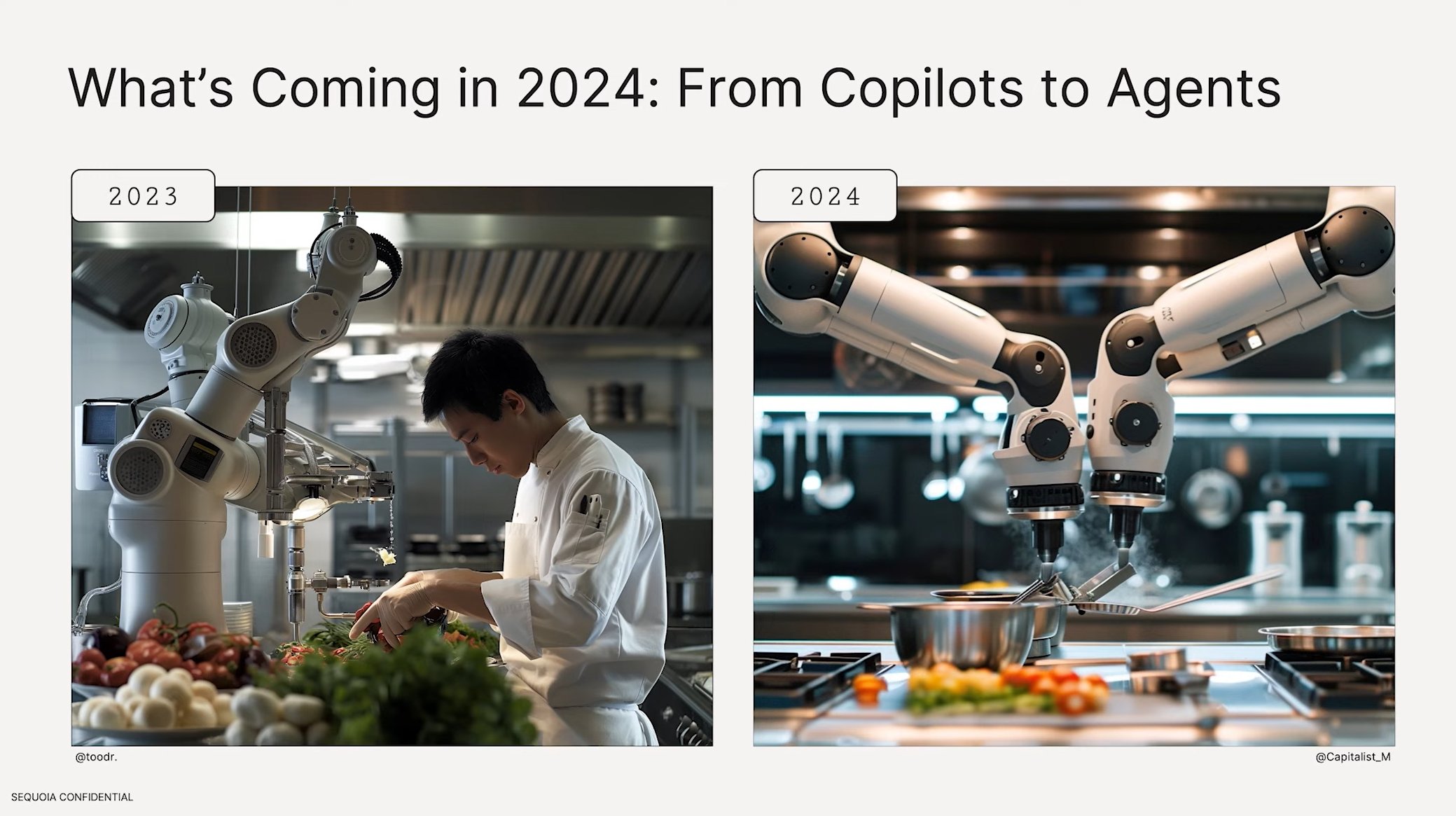
The same is true in the field of writing. Writing was originally purely a human endeavor. Then came machine assistance, such as grammar check tools. Now, when I write, I don't just use one AI assistant, but multiple models such as GPT-4, LLaMA, and Claude, which collaborate and compete to provide better results. This is the future.
What does this revolution mean for each of us? In the simplest economic terms, it means a significant reduction in costs. The graph shows that the number of employees needed for S&P 500 companies to generate $1 million in revenue is rapidly decreasing. We are entering a stage where this trend will continue. The good news is that this is not to make us do less, but to enable us to do more.
Moreover, all previous productivity revolutions eventually led to deflation. For example, the cost of computer software has been decreasing because we continue to innovate on existing foundations, and the same applies to television sets. However, the most important areas of our society, such as education, healthcare, and real estate, have seen costs rising much faster than inflation. It is comforting to know that AI has the potential to help reduce the costs in these critical areas.
This is my first judgment regarding AI as a large-scale cost and productivity revolution. It will help us do more and create more value in the most critical areas of our society, such as education and healthcare.
The second judgment involves the nature of AI. A year ago, Jensen Huang, the CEO of Nvidia, made a bold prediction on stage. He said that in the future, images will no longer be rendered but generated. Any visual information will be created. What did he mean by this? We all know that traditionally, images are stored as raw data. For example, the letter "A" is represented by ASCII code 97. It is depicted as a pixel matrix, black or white. However, we are now starting to represent the letter "A" as an abstract, multidimensional concept. The image of the letter "A" should evoke thoughts of a letter that can be presented in different fonts and styles. In this multidimensional space, we are at the center, surrounded by various specific rendering forms. What will happen next? Computers can not only understand this multidimensional concept and render it into an image, but also comprehend its context. For example, when it sees the word "multidimensional," it does not think of the letter "A," but understands the overall meaning of the word.
Even more amazingly, this reflects the way humans think. We do not remember the letter "A" as a pile of pixels, but as an abstract concept. This way of thinking can be traced back to 2500 years ago when Plato proposed the theory of forms, suggesting that behind any specific object, there is a beautiful abstract form.
What does this mean for each of us? It has a profound impact on entrepreneurs. We have already begun integrating AI into specific business processes and KPIs, such as Klarna's use of AI to enhance customer service metrics. They know exactly which key metrics they need to improve and have a system to retrieve information and generate personalized customer experiences. In the future, with the emergence of a new AI-driven human-machine interaction, the entire company may start operating like a neural network.
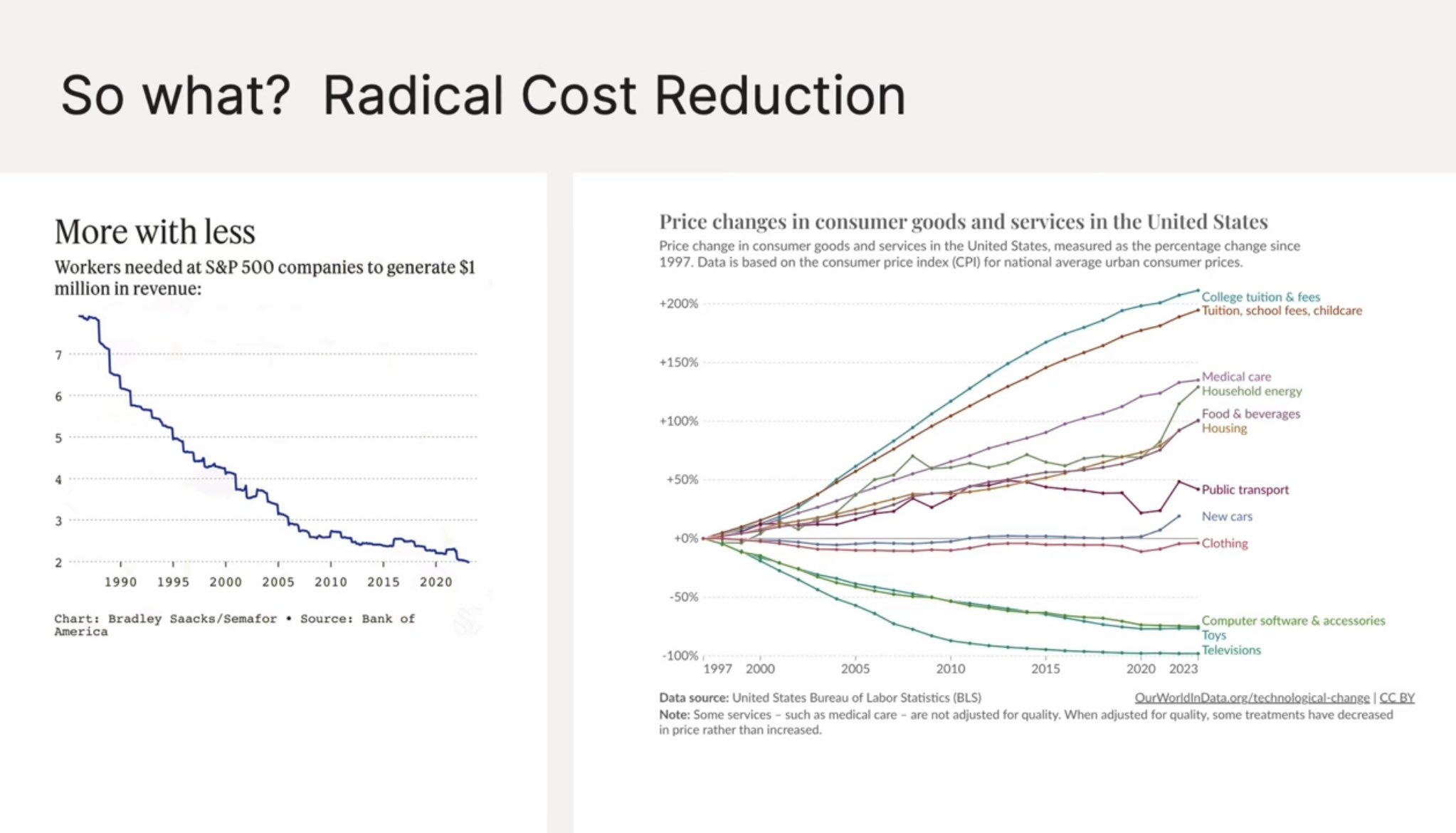
I'll provide a specific example. This is a simplified representation of a customer service process. The customer service department has some key metrics, driven by AI capabilities such as text-to-speech, language generation, and personalized customer interactions. These capabilities, in turn, form sub-processes and sub-optimization targets, and ultimately result in a fully connected diagram. Language generation will provide feedback to the final goal of customer service. Through abstraction, the customer service process will be managed, optimized, and improved by a neural network.
Looking at the customer acquisition phase for businesses, from language generation to growth engines, and from customized advertising to optimization, these are all basic AI units. Ultimately, these abstract layers will become highly interoperable, enabling the entire company to operate like a neural network. This has led to the rise of the "one-person company," which is not intended to make individuals do less, but to enable them to more
You are creating the future. Ultimately, it is up to each of you to decide what comes next. I am very optimistic about the prospects, as I believe that artificial intelligence will significantly enhance productivity and reduce costs in the most critical areas, such as education and healthcare. Today, we have gathered everyone to discuss how to use artificial intelligence to simplify complexity, reduce repetitive labor, and create more valuable things.


